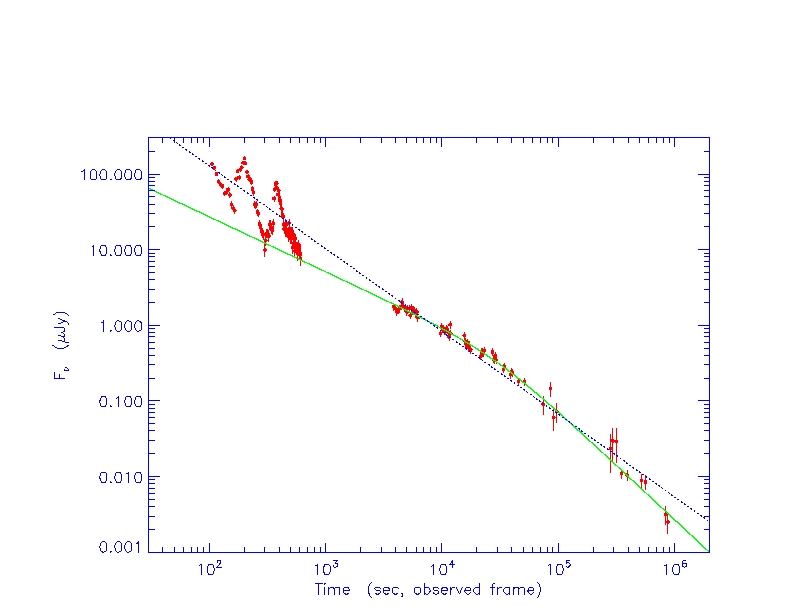(All information courtesy of the instrument teams.)
![]() Previous IAU Circulars
Previous IAU Circulars
TITLE: GCN/SWIFT NOTICE
NOTICE_DATE: Fri 10 Feb 06 04:59:15 UT
NOTICE_TYPE: Swift-BAT GRB Position
TRIGGER_NUM: 180977, Seg_Num: 0
GRB_RA: 57.730d {+03h 50m 55s} (J2000),
57.823d {+03h 51m 17s} (current),
56.970d {+03h 47m 53s} (1950)
GRB_DEC: +27.026d {+27d 01' 33"} (J2000),
+27.044d {+27d 02' 38"} (current),
+26.875d {+26d 52' 32"} (1950)
GRB_ERROR: 3.00 [arcmin radius, statistical only]
GRB_INTEN: 5140 [cnts] Image_Peak=204 [image_cnts]
TRIGGER_DUR: 1.024 [sec]
TRIGGER_INDEX: 155 E_range: 50-350 keV
BKG_INTEN: 26724 [cnts]
BKG_TIME: 17910.99 SOD {04:58:30.99} UT
BKG_DUR: 8 [sec]
GRB_DATE: 13776 TJD; 41 DOY; 06/02/10
GRB_TIME: 17929.80 SOD {04:58:49.80} UT
GRB_PHI: 178.62 [deg]
GRB_THETA: 44.14 [deg]
SOLN_STATUS: 0x3
RATE_SIGNIF: 27.58 [sigma]
IMAGE_SIGNIF: 8.42 [sigma]
MERIT_PARAMS: +1 +0 +0 -1 +3 +10 +0 +0 +17 +1
SUN_POSTN: 323.69d {+21h 34m 47s} -14.40d {-14d 23' 47"}
SUN_DIST: 100.09 [deg] Sun_angle= -6.3 [hr] (East of Sun)
MOON_POSTN: 110.74d {+07h 22m 58s} +27.13d {+27d 07' 33"}
MOON_DIST: 46.74 [deg]
MOON_ILLUM: 92 [%]
GAL_COORDS: 165.17,-20.77 [deg] galactic lon,lat of the burst (or transient)
ECL_COORDS: 61.39, 6.74 [deg] ecliptic lon,lat of the burst (or transient)
COMMENTS: SWIFT-BAT GRB Coordinates.
COMMENTS: This is a rate trigger.
COMMENTS: A point_source was found.
COMMENTS: This does not match any source in the on-board catalog.
COMMENTS: This does not match any source in the ground catalog.
COMMENTS: This is a GRB.
COMMENTS: This trigger occurred at longitude,latitude = 249.59,11.86 [deg].
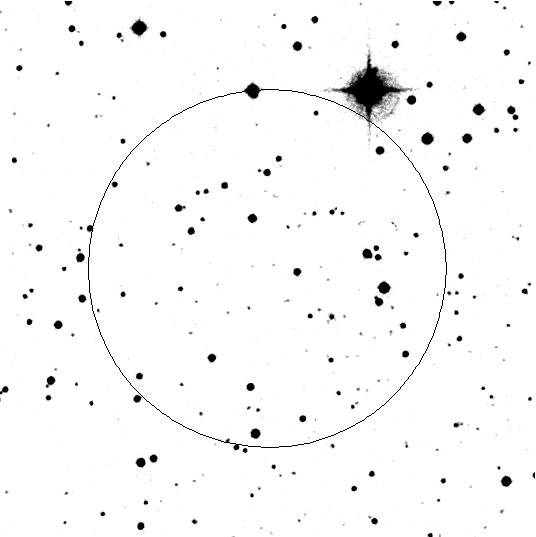
TITLE: GCN/SWIFT NOTICE
NOTICE_DATE: Fri 10 Feb 06 05:00:56 UT
NOTICE_TYPE: Swift-XRT Image
TRIGGER_NUM: 180977, Seg_Num: 0
GRB_RA: 57.7384d {+03h 50m 57.2s} (J2000),
57.8314d {+03h 51m 19.5s} (current),
56.9787d {+03h 47m 54.8s} (1950)
GRB_DEC: +27.0273d {+27d 01' 38.2"} (J2000),
+27.0454d {+27d 02' 43.5"} (current),
+26.8771d {+26d 52' 37.6"} (1950)
GRB_ERROR: 5.4 [arcsec, radius, statistical plus systematic]
GRB_INTEN: 140 [cnts]
IMG_START_DATE: 13776 TJD; 41 DOY; 06/02/10
IMG_START_TIME: 18024.75 SOD {05:00:24.75} UT, 95.0 [sec] since BAT Trigger Time
CENTROID_X: 335.83, raw= 336 [pixels]
CENTROID_Y: 295.97, raw= 296 [pixels]
ROLL: 258.81 [deg]
GAIN: 2
MODE: 3, Long Image mode
WAVEFORM: 134
EXPO_TIME: 2.50 [sec]
GRB_POS_XRT_Y: -6.65
GRB_POS_XRT_Z: 81.41
IMAGE_URL: sw00180977000msxim.img
SUN_POSTN: 323.70d {+21h 34m 47s} -14.40d {-14d 23' 45"}
SUN_DIST: 100.09 [deg] Sun_angle= -6.3 [hr] (East of Sun)
MOON_POSTN: 110.76d {+07h 23m 02s} +27.12d {+27d 07' 25"}
MOON_DIST: 46.75 [deg]
MOON_ILLUM: 92 [%]
GAL_COORDS: 165.17,-20.77 [deg] galactic lon,lat of the burst
ECL_COORDS: 61.39, 6.74 [deg] ecliptic lon,lat of the burst
COMMENTS: SWIFT-XRT Image.

TITLE: GCN/SWIFT NOTICE
NOTICE_DATE: Fri 10 Feb 06 05:00:55 UT
NOTICE_TYPE: Swift-XRT Position
TRIGGER_NUM: 180977, Seg_Num: 0
GRB_RA: 57.7384d {+03h 50m 57.2s} (J2000),
57.8314d {+03h 51m 19.5s} (current),
56.9787d {+03h 47m 54.8s} (1950)
GRB_DEC: +27.0273d {+27d 01' 38.2"} (J2000),
+27.0454d {+27d 02' 43.5"} (current),
+26.8771d {+26d 52' 37.6"} (1950)
GRB_ERROR: 5.4 [arcsec radius, statistical plus systematic, 90% containment]
GRB_INTEN: 4.61e-09 [erg/cm2/sec]
GRB_SIGNIF: 11.83 [sigma]
IMG_START_DATE: 13776 TJD; 41 DOY; 06/02/10
IMG_START_TIME: 18024.75 SOD {05:00:24.75} UT, 95.0 [sec] since BAT Trigger Time
TAM[0-3]: 327.63 237.21 261.30 243.21
AMPLIFIER: 2
WAVEFORM: 134
SUN_POSTN: 323.70d {+21h 34m 47s} -14.40d {-14d 23' 45"}
SUN_DIST: 100.09 [deg] Sun_angle= -6.3 [hr] (East of Sun)
MOON_POSTN: 110.76d {+07h 23m 02s} +27.12d {+27d 07' 25"}
MOON_DIST: 46.75 [deg]
MOON_ILLUM: 92 [%]
GAL_COORDS: 165.17,-20.77 [deg] galactic lon,lat of the burst
ECL_COORDS: 61.39, 6.74 [deg] ecliptic lon,lat of the burst
COMMENTS: SWIFT-XRT Coordinates.
COMMENTS: The object found at this position is either a very bright burst or a cosmic ray hit.
COMMENTS: Examine the XRT Image to differentiate (CRs are much more compact; see examples at:
COMMENTS: http://www.swift.psu.edu/xrt/XRT_Postage_Stamp_Image_Photo_Gallery.htm .
TITLE: GCN/SWIFT NOTICE
NOTICE_DATE: Fri 10 Feb 06 05:01:43 UT
NOTICE_TYPE: Swift-XRT Processed Image
TRIGGER_NUM: 180977, Seg_Num: 0
GRB_RA: 57.7384d {+03h 50m 57.2s} (J2000),
57.8314d {+03h 51m 19.5s} (current),
56.9787d {+03h 47m 54.8s} (1950)
GRB_DEC: +27.0273d {+27d 01' 38.2"} (J2000),
+27.0454d {+27d 02' 43.5"} (current),
+26.8771d {+26d 52' 37.6"} (1950)
GRB_ERROR: 5.4 [arcsec, radius, statistical plus systematic]
GRB_INTEN: 140 [cnts]
IMG_START_DATE: 13776 TJD; 41 DOY; 06/02/10
IMG_START_TIME: 18024.75 SOD {05:00:24.75} UT, 95.0 [sec] since BAT Trigger Time
CENTROID_X: 335.83, raw= 336 [pixels]
CENTROID_Y: 295.97, raw= 296 [pixels]
ROLL: 258.81 [deg]
GAIN: 2
MODE: 3, Long Image mode
WAVEFORM: 134
EXPO_TIME: 2.50 [sec]
GRB_POS_XRT_Y: -6.65
GRB_POS_XRT_Z: 81.41
IMAGE_URL: sw00180977000msxim.img
SUN_POSTN: 323.70d {+21h 34m 47s} -14.40d {-14d 23' 45"}
SUN_DIST: 100.09 [deg] Sun_angle= -6.3 [hr] (East of Sun)
MOON_POSTN: 110.76d {+07h 23m 03s} +27.12d {+27d 07' 21"}
MOON_DIST: 46.76 [deg]
MOON_ILLUM: 92 [%]
GAL_COORDS: 165.17,-20.77 [deg] galactic lon,lat of the burst
ECL_COORDS: 61.39, 6.74 [deg] ecliptic lon,lat of the burst
COMMENTS: SWIFT-XRT Processed Image.

TITLE: GCN/SWIFT NOTICE
NOTICE_DATE: Fri 10 Feb 06 05:02:41 UT
NOTICE_TYPE: Swift-BAT GRB Lightcurve
TRIGGER_NUM: 180977, Seg_Num: 0
GRB_RA: 57.730d {+03h 50m 55s} (J2000),
57.823d {+03h 51m 17s} (current),
56.970d {+03h 47m 53s} (1950)
GRB_DEC: +27.026d {+27d 01' 33"} (J2000),
+27.044d {+27d 02' 38"} (current),
+26.875d {+26d 52' 32"} (1950)
GRB_DATE: 13776 TJD; 41 DOY; 06/02/10
GRB_TIME: 17929.80 SOD {04:58:49.80} UT
TRIGGER_INDEX: 155
GRB_PHI: 178.62 [deg]
GRB_THETA: 44.14 [deg]
DELTA_TIME: 39.00 [sec]
TRIGGER_DUR: 1.024 [sec]
SOLN_STATUS: 0x3
RATE_SIGNIF: 27.58 [sigma]
IMAGE_SIGNIF: 8.42 [sigma]
LC_URL: sw00180977000msb.lc
SUN_POSTN: 323.70d {+21h 34m 47s} -14.40d {-14d 23' 44"}
SUN_DIST: 100.08 [deg] Sun_angle= -6.3 [hr] (East of Sun)
MOON_POSTN: 110.77d {+07h 23m 05s} +27.12d {+27d 07' 16"}
MOON_DIST: 46.77 [deg]
MOON_ILLUM: 92 [%]
GAL_COORDS: 165.17,-20.77 [deg] galactic lon,lat of the burst (or transient)
ECL_COORDS: 61.39, 6.74 [deg] ecliptic lon,lat of the burst (or transient)
COMMENTS: SWIFT-BAT GRB Lightcurve.
COMMENTS:
COMMENTS: The next comments were copied from the BAT_POS Notice:
COMMENTS: This is a rate trigger.
COMMENTS: A point_source was found.
COMMENTS: This does not match any source in the on-board catalog.
COMMENTS: This does not match any source in the ground catalog.
COMMENTS: This is a GRB.
COMMENTS: This trigger occurred at longitude,latitude = 249.59,11.86 [deg].
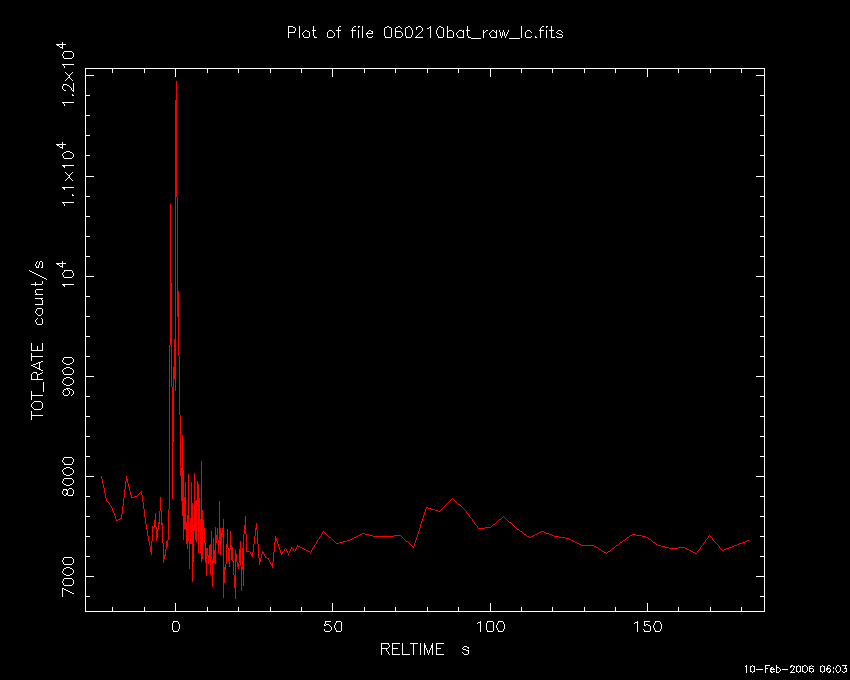
TITLE: GCN/SWIFT NOTICE
NOTICE_DATE: Fri 10 Feb 06 05:04:42 UT
NOTICE_TYPE: Swift-UVOT Source List
TRIGGER_NUM: 180977, Seg_Num: 0
POINT_RA: 57.714d {+03h 50m 51s} (J2000)
POINT_DEC: +27.021d {+27d 01' 15"} (J2000)
POINT_ROLL: 258.813d
IMG_START_DATE: 13776 TJD; 41 DOY; 06/02/10
IMG_START_TIME: 18027.82 SOD {05:00:27.82} UT, 98.0 [sec] since BAT Trigger Time
FILTER: 3, V
BKG_MEAN: 1.270
N_STARS: 101
X_OFFSET: 333 [pixels]
Y_OFFSET: 630 [pixels]
X_MAX: 1292 [pixels]
Y_MAX: 1589 [pixels]
DET_THRESH: 10
PHOTO_THRESH: 4
SL_URL: sw00180977000msufc0098.fits
SUN_POSTN: 323.70d {+21h 34m 48s} -14.40d {-14d 23' 42"}
SUN_DIST: 100.07 [deg] Sun_angle= -6.3 [hr] (East of Sun)
MOON_POSTN: 110.79d {+07h 23m 10s} +27.12d {+27d 07' 06"}
MOON_DIST: 46.80 [deg]
MOON_ILLUM: 92 [%]
GAL_COORDS: 165.16,-20.79 [deg] galactic lon,lat of the pointing direction
ECL_COORDS: 61.37, 6.73 [deg] ecliptic lon,lat of the pointing direction
COMMENTS: SWIFT-UVOT Source List.
TITLE: GCN/SWIFT NOTICE
NOTICE_DATE: Fri 10 Feb 06 05:05:31 UT
NOTICE_TYPE: Swift-UVOT Processed Source List
TRIGGER_NUM: 180977, Seg_Num: 0
POINT_RA: 57.714d {+03h 50m 51s} (J2000)
POINT_DEC: +27.021d {+27d 01' 15"} (J2000)
POINT_ROLL: 258.813d
IMG_START_DATE: 13776 TJD; 41 DOY; 06/02/10
IMG_START_TIME: 18027.82 SOD {05:00:27.82} UT, 98.0 [sec] since BAT Trigger Time
FILTER: 3, V
BKG_MEAN: 1.270
N_STARS: 101
X_OFFSET: 333 [pixels]
Y_OFFSET: 630 [pixels]
X_MAX: 1292 [pixels]
Y_MAX: 1589 [pixels]
DET_THRESH: 10
PHOTO_THRESH: 4
SL_URL: sw00180977000msufc0098.fits
SUN_POSTN: 323.70d {+21h 34m 48s} -14.40d {-14d 23' 42"}
SUN_DIST: 100.07 [deg] Sun_angle= -6.3 [hr] (East of Sun)
MOON_POSTN: 110.80d {+07h 23m 12s} +27.12d {+27d 07' 02"}
MOON_DIST: 46.81 [deg]
MOON_ILLUM: 92 [%]
GAL_COORDS: 165.16,-20.79 [deg] galactic lon,lat of the pointing direction
ECL_COORDS: 61.37, 6.73 [deg] ecliptic lon,lat of the pointing direction
COMMENTS: SWIFT-UVOT Processed Source List.
COMMENTS: All 4 attachments are included.
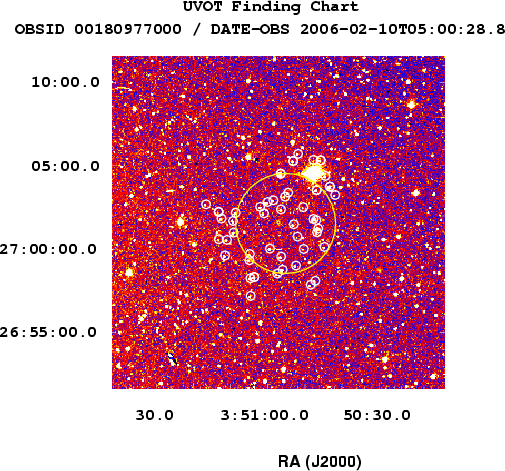
TITLE: GCN/SWIFT NOTICE
NOTICE_DATE: Fri 10 Feb 06 05:06:00 UT
NOTICE_TYPE: Swift-UVOT Image
TRIGGER_NUM: 180977, Seg_Num: 0
POINT_RA: 57.714d {+03h 50m 51s} (J2000)
POINT_DEC: +27.021d {+27d 01' 15"} (J2000)
ROLL: 258.813d
IMG_START_DATE: 13776 TJD; 41 DOY; 06/02/10
IMG_START_TIME: 18027.82 SOD {05:00:27.82} UT, 98.0 [sec] since BAT Trigger Time
FILTER: 3, V
EXPOSURE_ID: 161240428
X_OFFSET: 653 [pixels]
Y_OFFSET: 950 [pixels]
WIDTH: 160 [pixels]
HEIGHT: 160 [pixels]
X_GRB_POS: 813
Y_GRB_POS: 1110
BINNING_INDEX: 1
IM_URL: sw00180977000msuni0098.fits
SUN_POSTN: 323.70d {+21h 34m 48s} -14.40d {-14d 23' 41"}
SUN_DIST: 100.07 [deg] Sun_angle= -6.3 [hr] (East of Sun)
MOON_POSTN: 110.80d {+07h 23m 13s} +27.12d {+27d 06' 60"}
MOON_DIST: 46.81 [deg]
MOON_ILLUM: 92 [%]
GAL_COORDS: 165.16,-20.79 [deg] galactic lon,lat of the pointing direction
ECL_COORDS: 61.37, 6.73 [deg] ecliptic lon,lat of the pointing direction
COMMENTS: SWIFT-UVOT Image.
COMMENTS: The GRB Position came from the XRT Position Command.
COMMENTS: The image has 2x2 binning (compression).
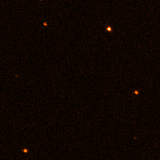
TITLE: GCN/SWIFT NOTICE
NOTICE_DATE: Fri 10 Feb 06 05:07:18 UT
NOTICE_TYPE: Swift-UVOT Processed Image
TRIGGER_NUM: 180977, Seg_Num: 0
POINT_RA: 57.714d {+03h 50m 51s} (J2000)
POINT_DEC: +27.021d {+27d 01' 15"} (J2000)
ROLL: 258.813d
IMG_START_DATE: 13776 TJD; 41 DOY; 06/02/10
IMG_START_TIME: 18027.82 SOD {05:00:27.82} UT, 98.0 [sec] since BAT Trigger Time
FILTER: 3, V
EXPOSURE_ID: 161240428
X_OFFSET: 653 [pixels]
Y_OFFSET: 950 [pixels]
WIDTH: 160 [pixels]
HEIGHT: 160 [pixels]
X_GRB_POS: 813
Y_GRB_POS: 1110
BINNING_INDEX: 1
IM_URL: sw00180977000msuni0098.fits
SUN_POSTN: 323.70d {+21h 34m 48s} -14.39d {-14d 23' 40"}
SUN_DIST: 100.07 [deg] Sun_angle= -6.3 [hr] (East of Sun)
MOON_POSTN: 110.82d {+07h 23m 16s} +27.11d {+27d 06' 53"}
MOON_DIST: 46.83 [deg]
MOON_ILLUM: 92 [%]
GAL_COORDS: 165.16,-20.79 [deg] galactic lon,lat of the pointing direction
ECL_COORDS: 61.37, 6.73 [deg] ecliptic lon,lat of the pointing direction
COMMENTS: SWIFT-UVOT Processed Image.
COMMENTS: The GRB Position came from the XRT Position Command.
COMMENTS: The image has 2x2 binning (compression).
COMMENTS: All 4 attachments are included.
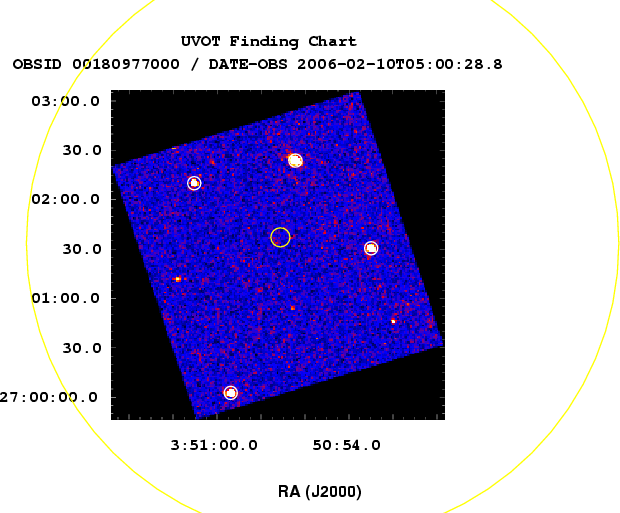
TITLE: GCN/SWIFT NOTICE
NOTICE_DATE: Fri 10 Feb 06 05:10:55 UT
NOTICE_TYPE: Swift-UVOT Source List
TRIGGER_NUM: 180977, Seg_Num: 0
POINT_RA: 57.714d {+03h 50m 51s} (J2000)
POINT_DEC: +27.023d {+27d 01' 24"} (J2000)
POINT_ROLL: 258.814d
IMG_START_DATE: 13776 TJD; 41 DOY; 06/02/10
IMG_START_TIME: 18234.68 SOD {05:03:54.68} UT, 304.9 [sec] since BAT Trigger Time
FILTER: 9, B
BKG_MEAN: 1.998
N_STARS: 136
X_OFFSET: 333 [pixels]
Y_OFFSET: 630 [pixels]
X_MAX: 1292 [pixels]
Y_MAX: 1589 [pixels]
DET_THRESH: 12
PHOTO_THRESH: 6
SL_URL: sw00180977000msufc0304.fits
SUN_POSTN: 323.70d {+21h 34m 49s} -14.39d {-14d 23' 37"}
SUN_DIST: 100.06 [deg] Sun_angle= -6.3 [hr] (East of Sun)
MOON_POSTN: 110.85d {+07h 23m 24s} +27.11d {+27d 06' 36"}
MOON_DIST: 46.86 [deg]
MOON_ILLUM: 92 [%]
GAL_COORDS: 165.16,-20.78 [deg] galactic lon,lat of the pointing direction
ECL_COORDS: 61.37, 6.74 [deg] ecliptic lon,lat of the pointing direction
COMMENTS: SWIFT-UVOT Source List.
TITLE: GCN/SWIFT NOTICE
NOTICE_DATE: Fri 10 Feb 06 05:11:45 UT
NOTICE_TYPE: Swift-UVOT Processed Source List
TRIGGER_NUM: 180977, Seg_Num: 0
POINT_RA: 57.714d {+03h 50m 51s} (J2000)
POINT_DEC: +27.023d {+27d 01' 24"} (J2000)
POINT_ROLL: 258.814d
IMG_START_DATE: 13776 TJD; 41 DOY; 06/02/10
IMG_START_TIME: 18234.68 SOD {05:03:54.68} UT, 304.9 [sec] since BAT Trigger Time
FILTER: 9, B
BKG_MEAN: 1.998
N_STARS: 136
X_OFFSET: 333 [pixels]
Y_OFFSET: 630 [pixels]
X_MAX: 1292 [pixels]
Y_MAX: 1589 [pixels]
DET_THRESH: 12
PHOTO_THRESH: 6
SL_URL: sw00180977000msufc0304.fits
SUN_POSTN: 323.70d {+21h 34m 49s} -14.39d {-14d 23' 37"}
SUN_DIST: 100.06 [deg] Sun_angle= -6.3 [hr] (East of Sun)
MOON_POSTN: 110.86d {+07h 23m 26s} +27.11d {+27d 06' 31"}
MOON_DIST: 46.86 [deg]
MOON_ILLUM: 92 [%]
GAL_COORDS: 165.16,-20.78 [deg] galactic lon,lat of the pointing direction
ECL_COORDS: 61.37, 6.74 [deg] ecliptic lon,lat of the pointing direction
COMMENTS: SWIFT-UVOT Processed Source List.
COMMENTS: All 4 attachments are included.
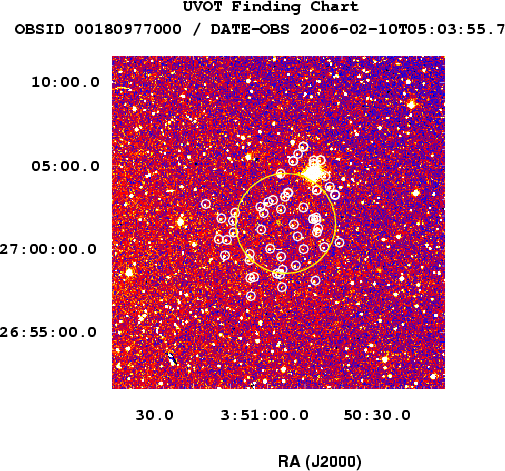
TITLE: GCN/SWIFT NOTICE
NOTICE_DATE: Fri 10 Feb 06 05:12:15 UT
NOTICE_TYPE: Swift-UVOT Image
TRIGGER_NUM: 180977, Seg_Num: 0
POINT_RA: 57.714d {+03h 50m 51s} (J2000)
POINT_DEC: +27.023d {+27d 01' 24"} (J2000)
ROLL: 258.814d
IMG_START_DATE: 13776 TJD; 41 DOY; 06/02/10
IMG_START_TIME: 18234.68 SOD {05:03:54.68} UT, 304.9 [sec] since BAT Trigger Time
FILTER: 9, B
EXPOSURE_ID: 161240635
X_OFFSET: 653 [pixels]
Y_OFFSET: 950 [pixels]
WIDTH: 160 [pixels]
HEIGHT: 160 [pixels]
X_GRB_POS: 813
Y_GRB_POS: 1110
BINNING_INDEX: 1
IM_URL: sw00180977000msuni0304.fits
SUN_POSTN: 323.70d {+21h 34m 49s} -14.39d {-14d 23' 36"}
SUN_DIST: 100.06 [deg] Sun_angle= -6.3 [hr] (East of Sun)
MOON_POSTN: 110.86d {+07h 23m 27s} +27.11d {+27d 06' 29"}
MOON_DIST: 46.87 [deg]
MOON_ILLUM: 92 [%]
GAL_COORDS: 165.16,-20.78 [deg] galactic lon,lat of the pointing direction
ECL_COORDS: 61.37, 6.74 [deg] ecliptic lon,lat of the pointing direction
COMMENTS: SWIFT-UVOT Image.
COMMENTS: The GRB Position came from the Window Position in the Mode Command.
COMMENTS: The image has 2x2 binning (compression).
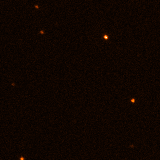
TITLE: GCN/SWIFT NOTICE
NOTICE_DATE: Fri 10 Feb 06 05:13:31 UT
NOTICE_TYPE: Swift-UVOT Processed Image
TRIGGER_NUM: 180977, Seg_Num: 0
POINT_RA: 57.714d {+03h 50m 51s} (J2000)
POINT_DEC: +27.023d {+27d 01' 24"} (J2000)
ROLL: 258.814d
IMG_START_DATE: 13776 TJD; 41 DOY; 06/02/10
IMG_START_TIME: 18234.68 SOD {05:03:54.68} UT, 304.9 [sec] since BAT Trigger Time
FILTER: 9, B
EXPOSURE_ID: 161240635
X_OFFSET: 653 [pixels]
Y_OFFSET: 950 [pixels]
WIDTH: 160 [pixels]
HEIGHT: 160 [pixels]
X_GRB_POS: 813
Y_GRB_POS: 1110
BINNING_INDEX: 1
IM_URL: sw00180977000msuni0304.fits
SUN_POSTN: 323.70d {+21h 34m 49s} -14.39d {-14d 23' 35"}
SUN_DIST: 100.06 [deg] Sun_angle= -6.3 [hr] (East of Sun)
MOON_POSTN: 110.87d {+07h 23m 30s} +27.11d {+27d 06' 23"}
MOON_DIST: 46.88 [deg]
MOON_ILLUM: 92 [%]
GAL_COORDS: 165.16,-20.78 [deg] galactic lon,lat of the pointing direction
ECL_COORDS: 61.37, 6.74 [deg] ecliptic lon,lat of the pointing direction
COMMENTS: SWIFT-UVOT Processed Image.
COMMENTS: The GRB Position came from the Window Position in the Mode Command.
COMMENTS: The image has 2x2 binning (compression).
COMMENTS: All 4 attachments are included.
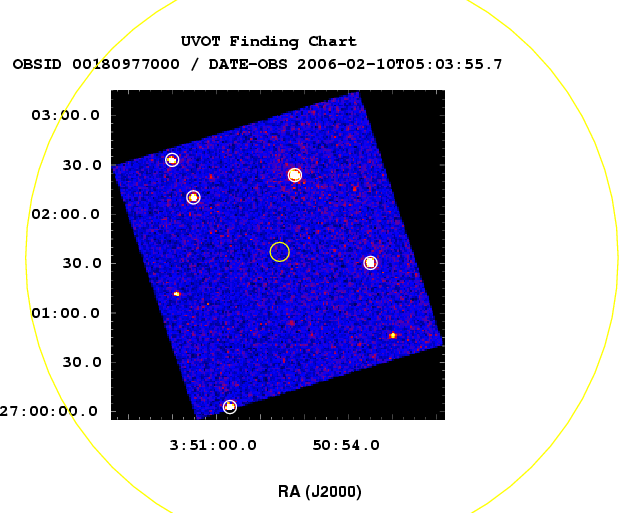
RA(J2000): 03:50:57.37 Dec(2000): +27:01:34.40(positional uncertaintly 0.5")
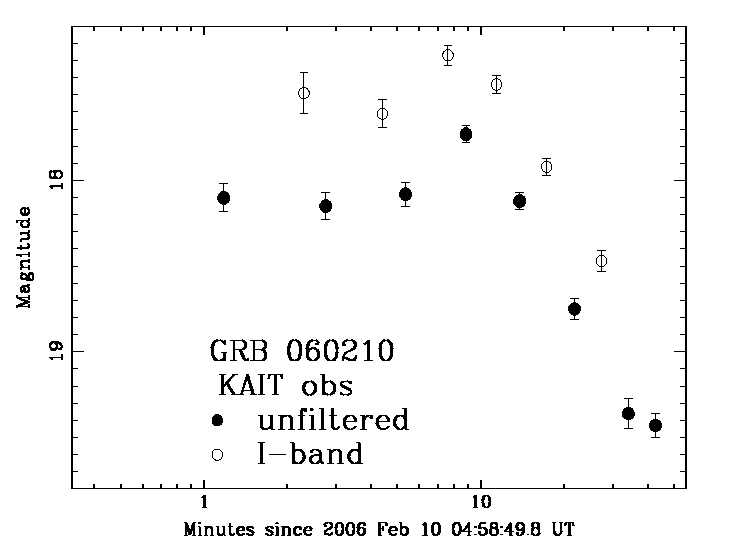
t obs (UT) exp t (s) t-t_0 (s) Limit -------------------------------------------------------- 04:59:44.9 10 55.1 R > 17.5Additional multi-band observations and analysis including image stacking are ongoing.
t_mid (UT) exp_t t_mid - t0 (s) R ----------------------------------------------------------------- 05:00:24.3 5 x 10 s 94.5 R = 18.25 +- 0.29 05:02:14.5 5 x 20 s 204.7 R = 18.30 +- 0.21Analysis is ongoing.
Delay time (hour) Filter Exp. limit site
Mean time (SN=3)
---------------------------------------------------------------------
5.79 R 600s x 1 19.5 Xinglong
5.97 I 600s x 1 18.7 Xinglong
6.18 R 300s x 3 20.8 Lulin
6.46 I 300s x 3 20.0 Lulin
This message may be cited."
RA(J2000) = 3h 50m 57.4s Dec(J2000) = +27d 01' 36.4"with an estimated uncertainty of 3.6 arcsec (90% containment). This position is 29.5 arcseconds from the BAT position given in GCN 4724 and 2.0 arcseconds from the optical afterglow position reported in GCN 4726 (Mundell et al).
Filter T_range(s) Exp(s) 3sigUL(mag) V 98-297 200 18.9 V 98-17151 1574 20.1 B 305-504 200 19.9 B 305-28728 2557 21.3 U 3750-27815 1594 20.6 UVW1 606-12060 1289 20.8 UVM2 582-17970 1402 21.1 UVW2 535-23754 2231 21.5 White 510-29539 2170 21.4These magnitudes are uncorrected for Galactic extinction; E(B-V) = 0.09.
